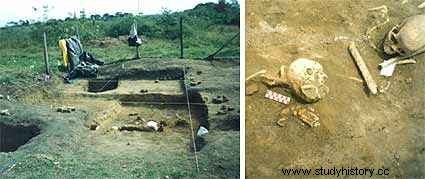
In the cemetery attached to a chapel destroyed in the early 19th century, bones of Tupi, mestizo and even black Indians were identified.
In the 16th century, the village of São Barnabé appeared, created by Jesuits to concentrate indigenous communities. If it still existed, it would occupy the area of the current municipality of Itaboraí (RJ), where traces of the presence of the Indians who lived there are still found today. This is what the doctoral thesis of archaeologist Nanci de Oliveira shows, recently defended at the State University of Campinas (Unicamp). She discovered two archaeological sites where Jesuits and Tupi peoples from the region lived. The finding brings up issues such as the organization of the space shared between them from the 16th to the 18th century and the relations of power and resistance established.
In addition to researching ancient documents and maps for four years, Nanci discovered an archaeological site where she and her team found ceramic materials, pots, coins and religious medals -- which confirm the presence of Jesuits there -- and a cemetery site. . There, four thousand bones were discovered belonging to 57 people, including Indians, mestizos and even blacks. "We also identified an Indian shot dead, which may indicate a not always friendly relationship between indigenous people and whites", she explains.
But not all the Indians in the region resisted the colonizers. In documents from the 17th century, Nanci identified a close relationship between some Tupi peoples and the Portuguese. "To protect their lands from foreign invasions, the indigenous people joined the Portuguese in defending the coast," she says. "His fidelity to certain rulers, such as Salvador Correa de Sá and Benevides, from Rio de Janeiro, went beyond the concept of political alliance. But of course, out of interest, the rulers also treated them differently."
With the expulsion of the Jesuits in the 18th century, the network of power in Rio de Janeiro changed. The Indians ceased to be important for defense and began to be required as manpower. "At that time, the village of São Barnabé passed to a lay administration, taken over by the Portuguese who had previously leased their lands to the Jesuits", says Nanci. "Then the rebellions intensified."
The researcher also explains that a policy of oblivion and prejudice on the part of historians dates from that time, who saw the indigenous as a delay for Brazil. "For them, Indians were a degenerating race. They were interested in showing Portuguese domination", she criticizes. Nanci believes that, as a reflection of this policy, the tipping of the São Barnabé region was denied by the authorities of Itaboraí. "They say that the place has already undergone previous renovations and is quite uncharacterized to be listed", she explains.
When traveling through the region, however, the researcher noticed some trails and milestones of the redefinition of the limits of indigenous territories that are still visible. Nanci made a map of the site and identified several points indicated in documents from the 16th and 17th centuries. Now, she intends to investigate other archaeological sites in Itaboraí and research the relationships established between colonized and colonizer.
